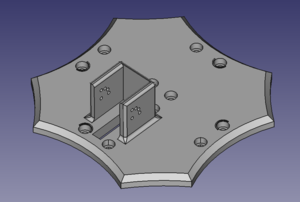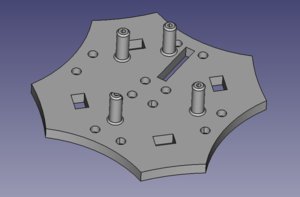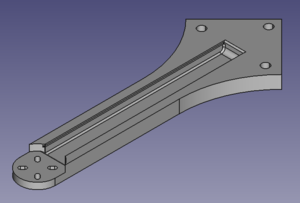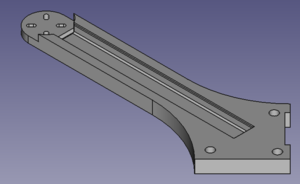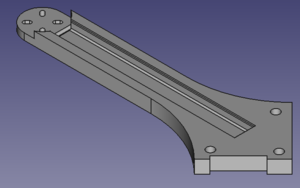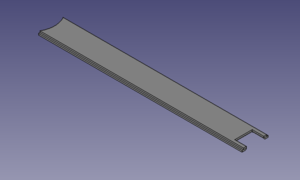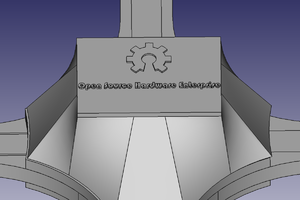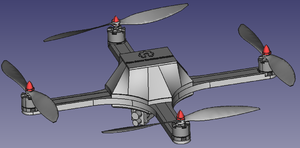
The goal of this Cinematography Quadcopter is to create an open source platform that can be used for areal photography and cinematography, and provide a platform that can be adjusted or manipulated based on the objectives of the quadcopter.
Background[edit | edit source]
The goal of this project is to create an open source quadcopter platform that is able to capture 4K resolution pictures and videos. This platform is based on previous open source hardware to control the software and electronics of the quadcopter, and the frame is designed using the open source software FreeCAD to make a 3D printed frame. This 3D printed frame and open source components makes the cost of this project minimal while maintaining a reliable and customizable platform. The quadcopter also contains features to make it weather resistant in order to increase its longevity.
Problem Statement[edit | edit source]
The current market options for a quadcopter that supports a 4K resolution camera are limited and expensive. Using common quadcopter components and open source options, this solution allows the common user to build off this existing platform to create the quadcopter to fit their needs. This platform allows the user to manipulate or change features on the frame while using software that is completely open source and free to the public. This eliminates the expensive costs of prototyping, and allows the user to customize the quadcopter to add additional payloads.
Project Significance[edit | edit source]
This quadcopter allows the user to create a customized platform to suit their cinematography needs. It allows the user to add additional payloads or alter the dimensions of the frame to make a larger or smaller quadcopter to fit each scenario.
Project Goals:
- Create a frame platform using open source software
- Use FreeCAD to create 3D models of the frame
- Use open source plugins in FreeCAD to create a 3D assembly of the frame
- Use open source plugins in FreeCAD to perform FEA analysis
- Withstand a fall while in flight
- Utilize PETG filament to 3D print the frame
- Control the quadcopter using a handheld remote control
- Utilize an Arduino Uno R3 to control the operations of the quadcopter
- Weather resistant
- Create a cover to house the essential components inside the center of the quadcopter
- Verify each components works properly on its own as well as with each other
- Create a demo of the quadcopter in flight and sample photos and videos
Future Goals:
- Create mounting for an additional payload
- The quadctoper will have an attachment on the underside to attach additional cameras or equipment
- Utilize the GoPro mounting system
- Attach a LiDAR sensor to the quadcopter
- Allows for the "Follow Me" function as well as autonomous hover
- Attach a GPS unit
- Allows for GPS location lock when paired with a LiDAR sensor for autonomous hovering
Part Choices[edit | edit source]
Because this quadcopter is open source, the components used to build the quadcopter must be accessible to everyone. Because of this, an Arduino Uno R3 was chosen as it is open source based and minimalistic. This Arduino is paired with the MultiWii drone software which allows the user to input the components chosen into the code and make adjustments. Because this software was chosen to fly the quadcopter, typical components were chosen to simplify the prototyping process. Emax MT2213-935KV motors were chosen as each motor can produce a maximum of 935kV, generating an excess of lift when paired with 10" propellers. This combination allows the quadcopter to carry an additional payload of a camera or other equipment without suffering from a lack of power. Because these high power motors were chosen, 30A BLHeli-S Rev16 V3 ESCs and a 3S lip battery were also chosen to power the motors. These components ensure that the motors are provided with plenty of power while being able to fly for an extended period of time. In order for the quadcopter to accurately determine its pitch, yaw, and roll, a GY85 9 degree of freedom IMU was implemented. Each of these components allows the quadcopter to fly safely and effectively. After these components were chosen, a camera must be chosen to deliver the 4k photos and videos. The camera that was chosen for this task was the RunCam Hybrid Micro FPV camera. This camera uses an onboard microSD card to capture the photos and videos eliminating the use of an external module.
Filament Choice[edit | edit source]
Since this quadcopter contains powerful motors, the frame must be able to withstand not only the forces of the motors, but also the force generated from a fall or crash. Because of this, PETG was the chosen material for the quadcopter to be made of due to its impressive material properties. The frame components were 3D printed using a Lulzbot Taz Pro using a nozzle that accepts 2.85mm filament.
Printing Settings[edit | edit source]
In order for the frame to be strong enough to survive a fall, a high infill density is used. An infill density of 80% with an infill pattern of triangles was used. This infill pattern and density allows the frame to be strong enough to survive a fall, but reduces the weight when compared to 100% infill pattern. The high detail setting was also used with a layer height of 0.18mm.
Frame Components[edit | edit source]
| Part | Description | Count |
|---|---|---|
| Bottom Plate with mount for the RunCam Hybrid Micro FPV Camera. | 1 | |
| Top plate with mounts for Arduino Uno R3. | 1 | |
| Rear arms. | 2 | |
| Front Left Arm. | 1 | |
| Front Right Arm. | 1 | |
| Sliding covers for the arms. | 4 | |
| Center cover to protect the essential electronics. | 1 |
Credits[edit | edit source]
Senior Design project developed by Dylan Mercier, Joaquin Ganoza, Harris Neill
